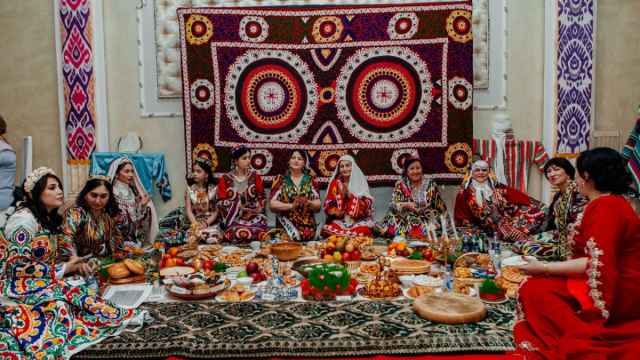Russian Corruption. Decadence. A princess becoming pregnant. Feminism. Sin. The eurozone crisis. The water cycle. These are some of the thoughts that can fall into and pile up in one's mind when viewing "Danaё," an installation from Vadim Zakharov featured this year in Russia's pavilion at the 55th Venice Biennale of contemporary art.
Every two years, the Biennale puts on a contemporary art show accompanied by separate pavilions from various countries. This year, the Russian pavilion's mix of political metaphor, innuendo and drama has drawn crowds and created a striking scene among an international collection of works all trying to create striking scenes.
Vadim Zakharov spoke with The Moscow Times about his installation at the Biennale, saying that "It was a platform where I couldn't speak my own incomprehensible language, my individual language. I preferred to take as a base something everyone knows, the myth of Danaё, that also describes the situation today really well."
The installation, spanning three floors of the building that Russia traditionally uses in Venice, plays on the ancient Greek myth of Danaё, a subject that has inspired artists from Rembrandt to Gustav Klimt.
After a prophecy foretells that her son will eventually kill him, Danaё's father, King Acrisius, locks the young girl away in a courtyard to stop the princess from having children. However, the god Zeus circumvents the king's protective measures by visiting Danaё as a golden rain shower and impregnating her with the legendary hero Perseus, who grew up and killed both his grandfather and the Medusa.
In Zakharov's piece, a sharply dressed oligarch dangles his feet from a beam and shucks peanuts while gold coins valued at "one Danaё" sprinkle down from the ceiling. The coins fall through a square opening in the second floor surrounded by church pew kneelers and form a glittering pile on the building's cave-like ground floor, which only women are allowed to enter. The women, armed with see-through umbrellas and accompanied by actresses in trench coats, can then place the coins in a bucket that carries them upward to another well-dressed man who restarts the cycle.
Meanings derived from the exhibit's visual aspects, like a critique of capitalist society or the artist's subtle snicker at the sexually-loaded term "golden shower", interact with the text in the piece: A litany of sins like lust and greed is written on a wall near the oligarch, and the words "Trust, Unity, Freedom, Love" are inscribed in the coins.
Perhaps what makes "Danaё" popular is that while it may be hard to sort out what to think about the piece when so many ideas are swirling around, it is not difficult to come up with something to think about given the abundance of clear images.
Observers have been keen on linking the work to a critique of politics in Russia, particularly President Vladimir Putin and the wealthy cadre of corrupt politicians and businessmen that surrounds him. While he attends opposition rallies, in an interview with Snob.ru Zakharov said, "Anyone who thinks that I should put up posters, branding the systems of the West and Russia-Putin, will be disappointed." He told The Moscow Times that while making the piece, he was thinking about everything from Russian politics to gender to the connection between the ancient myth and the eurozone's fiscal policy toward Greece.
Indeed, the set up of the Venice Biennale, with audiences browsing and sampling the different national flavors of contemporary art, may lead to the impression that each artist represents the distilled national character of his or her country. However Zakharov, who splits his time between Moscow and Berlin and worked with German curator Udo Kittelmann on Danaё, expressed reservations about the fact that some may see him as a symbol of Russia or a voice for its political tensions. "I don't answer for the country. I answer for a small region of Russian contemporary art. For my small part I am responsible, not for all the rest," he said during a lecture last week at the State Center for Contemporary Art.
And Zakharov has been a part of the contemporary art world for 30 years. Born in Tajikistan in 1959, he moved to Moscow for university and got his start in the early '80s Moscow Conceptualist group that included Ilya Kabakov and Lev Rubinshtein and whose influence can seen in the idea-driven antics of the dissident art collective Voina. Zakharov has since risen to national and international prominence, winning the Kandinsky prize in 2009 for his piece "St. Sebastian Near the Boiling Oatmeal" and exhibiting throughout the world. Perhaps his most famous work is his monument to the late philosopher Theodor Adorno in Frankfurt, Germany, where a glass cube encases an empty chair, desk, lamp and metronome.
However, the visitors enjoying his exhibition in Italy do not all have master's degrees in critical theory, and Danaё may be more accessible to those uninitiated in the contemporary art world than Zakharov's previous works. While he rejects simplifying his work into a critique of Putin, he says he knew that he could not reproduce the intellectual style of his previous works at the Biennale.
"Every artist, naturally, has his own language. I am interested in speaking straight away in several languages — maybe even dead languages. For this reason, almost all of my projects have several cultural layers, each with their own descriptive language," Zakharov said. In Danaё, Zakharov says he seized on the power of the well recognized myth to make his language comprehensible to more viewers.
Zakharov's preoccupation with language will come to Moscow later this month in a show that may be even more geared towards the masses, or at least people who can afford to shop at the high-end stores in TsUM. His project for the Moscow Biennial of Contemporary Art, "The Dance of Dead Languages," will take place on the mall's fifth floor and feature skeletons wearing the latest fashions as well as a baby in a stroller talking on a cellphone.
"Danaё" will be on display at the Russian pavilion of the Venice Biennale until Nov. 24. "The Dance of Dead Languages" begins Friday, Sept. 20 at TsUM, 2 Petrovka Ulitsa.
Contact the author at c.brennan@imedia.ru
A Message from The Moscow Times:
Dear readers,
We are facing unprecedented challenges. Russia's Prosecutor General's Office has designated The Moscow Times as an "undesirable" organization, criminalizing our work and putting our staff at risk of prosecution. This follows our earlier unjust labeling as a "foreign agent."
These actions are direct attempts to silence independent journalism in Russia. The authorities claim our work "discredits the decisions of the Russian leadership." We see things differently: we strive to provide accurate, unbiased reporting on Russia.
We, the journalists of The Moscow Times, refuse to be silenced. But to continue our work, we need your help.
Your support, no matter how small, makes a world of difference. If you can, please support us monthly starting from just $2. It's quick to set up, and every contribution makes a significant impact.
By supporting The Moscow Times, you're defending open, independent journalism in the face of repression. Thank you for standing with us.
Remind me later.






